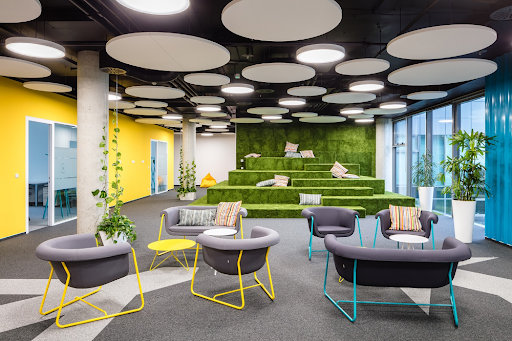
In the fast-paced world of commercial interior design, staying ahead of the curve is essential. With technological advancements shaping every aspect of our lives, it’s no surprise that the world of design has also embraced these innovations to create stunning and functional spaces. This holds particularly true in bustling cities like Sydney, where the demand for cutting-edge commercial interiors is rising. Technology plays a pivotal role in shaping the future of commercial interior design in Sydney, from augmented reality to sustainable materials.
Augmented Reality (AR) and Virtual Reality (VR)
Augmented Reality (AR) and Virtual Reality (VR) revolutionise how designers and clients interact with commercial interiors. In the past, clients often had to rely on 2D blueprints and renderings to visualise the outcome. However, with AR and VR technologies, designers can now create immersive experiences that allow clients to walk through their future spaces virtually.
For example, a client looking to design a trendy cafe in Sydney can use a VR headset to explore the interior layout, colour schemes, furniture placements, and lighting choices in a realistic, 3D environment. This technology enables clients to make more informed decisions and provide valuable feedback before the physical work begins, reducing the likelihood of costly design changes later.
Sustainable Materials and Green Design
Sustainability is a driving force in modern design, and Sydney is no exception. Technology has enabled designers to access many sustainable materials and techniques that contribute to creating eco-friendly commercial interiors. Technology plays a vital role in making environmentally-conscious design choices, from energy-efficient lighting systems to recycled building materials.
Furthermore, integrating Building Information Modeling software allows designers to analyse the environmental impact of different design elements. This enables them to make informed decisions about materials, energy consumption, and waste reduction. Sydney’s emphasis on sustainability aligns perfectly with this technological advancement, promoting aesthetically-pleasing and environmentally-responsible commercial interiors.
Smart Automation and IoT Integration
Innovative technology is transforming the way commercial spaces function. The Internet of Things (IoT) has paved the way for connected and automated environments that enhance user experiences and improve efficiency. In Sydney, this technology is seamlessly integrated into commercial interior designs to create smart offices, retail spaces, and hospitality venues.
Imagine a futuristic office space where lighting, temperature, and even coffee machines are controlled through a smartphone app. This level of automation adds convenience and contributes to energy conservation. By optimising energy consumption based on occupancy and usage patterns, technology-driven smart interiors align with Sydney’s push toward sustainable urban development.
Collaborative Design Tools
Designing commercial interiors often involves collaboration among stakeholders, including architects, designers, contractors, and clients. Technology has significantly eased collaboration by providing advanced tools for real-time communication and project management.
Cloud-based platforms allow team members to access design files, 3D models, and project updates from any location, streamlining communication and reducing the risk of miscommunication. This is particularly important in a city like Sydney, where professionals might be spread out across different locations. Seamless collaboration ensures that the final design reflects all stakeholders’ collective vision and expertise.
Customisation and Personalisation
In the bustling commercial landscape of Sydney, businesses strive to stand out from the crowd. Technology empowers designers to create customised and personalised interiors that resonate with a brand’s identity. Advanced design software enables the creation of bespoke furniture, fixtures, and interior elements, allowing businesses to create unique environments that leave a lasting impression on customers.
From hospitality establishments to retail spaces, this technology-driven customisation aligns with Sydney’s diverse and vibrant commercial scene, catering to its clientele’s unique needs and tastes.
Biophilic Design and Virtual Greenery
The connection to nature can sometimes be lost in a bustling urban environment like Sydney. However, technology allows designers to bring the outdoors inside through biophilic design. With the help of high-quality displays and projection mapping, virtual greenery and natural landscapes can be integrated into commercial interiors. This enhances the aesthetics and contributes to the well-being of occupants by creating a calming and refreshing atmosphere. Sydney’s love for its natural surroundings is beautifully complemented by this fusion of technology and nature in interior design.
Acoustic and Soundscaping Solutions
Busy commercial areas in Sydney sometimes suffer from noise pollution, affecting employee productivity and customer experiences. Advanced acoustic modelling software helps designers analyse and optimise soundscapes within commercial spaces. This technology assists in the selection of appropriate materials, layouts, and sound-absorbing elements to create comfortable and acoustically-pleasing interiors. Whether it’s a lively cafe or a bustling office, integrating sound-focused technology ensures that Sydney’s commercial interiors are both visually appealing and audibly serene.
Digital Signage and Interactive Displays
The fast-paced consumer environment of Sydney’s retail and hospitality sectors demands attention-grabbing ways to engage customers. Digital signage and interactive displays have become indispensable tools for businesses aiming to captivate their audience. From dynamic menu boards in restaurants to interactive product displays in retail stores, technology-driven design elements provide information and create memorable and immersive experiences. Sydney’s tech-savvy populace embraces these interactive installations, making them an integral part of the city’s commercial interiors.
Conclusion
Technology’s role in designing commercial interiors in Sydney goes far beyond aesthetics. It’s a driving force behind innovation, sustainability, efficiency, and customer satisfaction. Augmented and virtual reality reshape how clients envision their spaces, while sustainable materials and smart automation align with the city’s eco-conscious and tech-savvy culture. Collaborative design tools ensure seamless teamwork, and customisation adds a personal touch to businesses striving for uniqueness.
As Sydney continues to evolve as a global commercial hub, integrating technology into interior design is not just a trend but a necessity. Embracing these technological advancements will shape the city’s skyline and elevate its reputation as a hub of innovative, functional, and aesthetically-captivating commercial interiors. The synergy between technology and design is poised to redefine the future of Sydney’s commercial spaces, offering a glimpse into a world where creativity knows no bounds.
